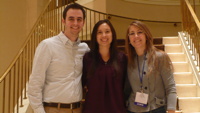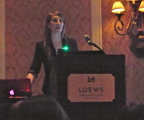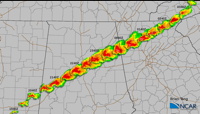Modeling Group News
Iowa Severe Storms Conference
Samantha Chiu gave a very well-received oral presentation at the 17th Annual Severe Storms and Doppler Radar Conference. Her talk was "Mesoscale and storm-scale ingredients of tornadic supercells producing long-track tornadoes in the 2011 Alabama Super Outbreak" on Friday, April 5.
Transitions, or Life After Graduation
Ann Syrowski has taken a position with The SAVO Group in Chicago. Kevin Van Leer's thesis is under review, and he has been offered and accepted a job to begin mid-summer.
Ann Syrowski: Large Data User
Ann Syrowski is officially a large data user, as she was named Globus Online User of the Month for transferring 100 TB between high performance computing centers (HPCs) using that facility. She was also a heavy HPC user as her research took her across six XSEDE supercomputer centers during her Master's research and work after graduation.
Conference Notebook Summary
Kevin Van Leer's SLS talk (see below) is the subject of a Bull. Amer. Meteor. Soc. (BAMS) Conference Notebook Summary, and was published (but not online yet!) in the February 2013 BAMS issue. The title is Rapid Intensification, Storm Merging, and the 2011 Joplin Tornado.
26th Severe Local Storms Conference (Nashville)

The AMS 26th Conference on Severe Local Storms was held in Nashville, TN from November 5-8, 2012. Attending from the Univ. Illinois Convective Modeling Group were (left-to-right in photo) M.S. graduate students Kevin Van Leer and Samantha Chiu, research assistant Ann Syrowski (M.S. May 2012), and
(not pictured) PI's Robert Wilhelmson and Brian Jewett. Kevin, Samantha, and Ann had oral presentations at the meeting.
Storm Interaction
 Ann Syrowski presented the findings of her M.S. thesis, "An assessment of internal and external forcings in supercell interactions and their impact on storm morphology." The structure and evolution similarities and differences among a single-storm control case and 51 two-storm simulations were discussed, and intensification mechanisms were identified. The dynamic connections between (and timings of) a key sequence of events were identified for the control and selected strong and weak 2-storm cases:
(1) wet microbursts reached the surface behind the forward flank downdraft (FFD), (2) shallow rotation centers formed along and moved down the FFD, and (3) subsequent near-surface rotation intensification episodes (mesocyclonesis) occurred. Ann is preparing a manuscript for submission to Monthly Weather Review.
Ann Syrowski presented the findings of her M.S. thesis, "An assessment of internal and external forcings in supercell interactions and their impact on storm morphology." The structure and evolution similarities and differences among a single-storm control case and 51 two-storm simulations were discussed, and intensification mechanisms were identified. The dynamic connections between (and timings of) a key sequence of events were identified for the control and selected strong and weak 2-storm cases:
(1) wet microbursts reached the surface behind the forward flank downdraft (FFD), (2) shallow rotation centers formed along and moved down the FFD, and (3) subsequent near-surface rotation intensification episodes (mesocyclonesis) occurred. Ann is preparing a manuscript for submission to Monthly Weather Review.
Long-Track Tornadoes: The April 27, 2011 Outbreak
 Samantha Chiu presented the findings of her ongoing master's work on long-track tornadoes and simulations of the 27 April 2011 tornado outbreak. Over 300 tornadoes struck the southeast U.S. in the outbreak*, including the devastating Tuscaloosa-Birmingham EF-4 tornado with a damage path 80 miles long and up to 1.5 miles wide (radar sequence at left, ©NCAR). Chiu's real-data simulations of the event, with high resolution (0.3-km grid spacing) simulations of the outbreak, feature two long-lived supercell storms including one very near the track and timing of the Birmingham storm. Samantha is using these simulations and complimentary idealized runs with the Weather Research and Forecasting (WRF) model to assess the environment along the path of the storms and understand the stability and shear conditions under which such a long-track tornado could occur.
Samantha Chiu presented the findings of her ongoing master's work on long-track tornadoes and simulations of the 27 April 2011 tornado outbreak. Over 300 tornadoes struck the southeast U.S. in the outbreak*, including the devastating Tuscaloosa-Birmingham EF-4 tornado with a damage path 80 miles long and up to 1.5 miles wide (radar sequence at left, ©NCAR). Chiu's real-data simulations of the event, with high resolution (0.3-km grid spacing) simulations of the outbreak, feature two long-lived supercell storms including one very near the track and timing of the Birmingham storm. Samantha is using these simulations and complimentary idealized runs with the Weather Research and Forecasting (WRF) model to assess the environment along the path of the storms and understand the stability and shear conditions under which such a long-track tornado could occur.
*See also AMS presentation by K. Knupp
Storm Mergers and Rapid Intensification in the 2011 Joplin Tornadic Storm
![]() Kevin Van Leer's talk was on "Rapid intensification mechanisms including the role of storm mergers in the 22 May 2011 Joplin, MO tornadic storm." The presentation first addressed the unusual and somewhat surprising severity and rapid development of the storm and the environmental conditions in place at the time of the devastating tornado in Joplin. Mechanisms which could contribute to this intensification were discussed, including storm mergers that occurred before the tornado. High-resolution (0.3 km) modeling of this case also produced mergers, and animations of simulated mergers, the structure and evolution of precipitation, and low level rotation in the simulation were used to investigate the relationship between boundaries, cell movement, descending reflectivity cores and near-surface vorticity generation. Kevin is continuing this work toward his M.S. degree. His presentation won a student award at the SLS meeting, and his preliminary findings are the subject of a Bulletin of the American Meteorology Society meeting note (accepted; in February BAMS).
Kevin Van Leer's talk was on "Rapid intensification mechanisms including the role of storm mergers in the 22 May 2011 Joplin, MO tornadic storm." The presentation first addressed the unusual and somewhat surprising severity and rapid development of the storm and the environmental conditions in place at the time of the devastating tornado in Joplin. Mechanisms which could contribute to this intensification were discussed, including storm mergers that occurred before the tornado. High-resolution (0.3 km) modeling of this case also produced mergers, and animations of simulated mergers, the structure and evolution of precipitation, and low level rotation in the simulation were used to investigate the relationship between boundaries, cell movement, descending reflectivity cores and near-surface vorticity generation. Kevin is continuing this work toward his M.S. degree. His presentation won a student award at the SLS meeting, and his preliminary findings are the subject of a Bulletin of the American Meteorology Society meeting note (accepted; in February BAMS).
13th WRF Users' Workshop (Boulder)
There were two posters presented at the 2012 NCAR WRF Workshop in Boulder, CO:
- Storm interaction: Ann Syrowski's poster, "Assessment of Supercell Mesocyclogenesis in a Suite of Idealized WRF Simulations of Storm Interaction" (P78) was presented by Brian Jewett this year. In it were details of Syrowski's Master's work, describing mesocyclogenesis mechanisms in the 51-member parameter study associated with forward flank gust front circulations. These circulations were traced back to downburst events north of the meso and behind the forward flank. See Syrowski's poster here.
- Joplin tornado: Kevin Van Leer presented "Investigating the Role of Storm Mergers and Rapid Storm Intensification Mechanisms in the 22 May 2011 Joplin, MO Tornadic Storm" (P79). Kevin outlined observations and early real-data modeling simulations of the Joplin storm, noting storm mergers in both the simulation and radar data for this case. Early simulations were characterized by an unrealistically strong cold pool, attributed to details of the microphysical treatment. See Kevin's poster here.
XSEDE 2012 (Chicago)
The Convective Modeling Group gave presentations at the XSEDE meeting in Chicago.
- Ann Syrowski's poster, New Paths to Understanding Severe Storm Intensification: A Numerical Modeling Study, described the research area, computational resources and methods used to analyze results of the large data sets from her Master's work.
- Brian Jewett's Science Track talk was Ensemble Modeling of Storm Interaction with XSEDE. He gave a brief history of cloud modeling, some of the challenges encountered in recent work, and a wish list of capabilities that would be helpful in computational science in our field. Brian's talk is available here.
Syrowski graduation; Continuing as post-M.S. Research Assistant
Ann Syrowski graduated with her Master of Science degree in May, 2012. Her M.S. thesis was Internal vs. external forcings in supercell interactions and their impact on storm morphology and intensity. Ann was offered and accepted a post-M.S. Research Assistant position to continue her research and prepare a manuscript for publication in Monthly Weather Review.
14th Mesoscale Processes Conference (Los Angeles)
At the AMS Mesoscale meeting in 2011:
- Ann Syrowski gave an oral presentation, Evaluating the contribution of storm-scale dynamic and microphysical processes to the intensification and longevity of interacting cells.
- Samantha Chiu's poster was The 2010 Mississippi Valley tornado outbreak - a mesoscale and stormscale perspective.

